






![]()
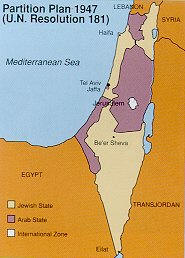 Partition Plan 1947 (UN Resolution 181):
Partition Plan 1947 (UN Resolution 181):In 1947, Great Britain relinquished to the UN the power to make decisions relating to the status of the Land of Israel. The General Assembly appointed a special committee that collected evidence and decided unanimously that Israel should be granted independence.
On 14 May 1948 the State of Israel was proclaimed according to the UN partition plan (1947). Less than 24 hours later, the regular armies of Egypt, Jordan, Syria, Lebanon and Iraq invaded the country, forcing Israel to defend the sovereignty it had regained in its ancestral homeland.
In what became known as Israel's War of Independence, the newly formed, poorly equipped Israel Defense Forces (IDF) repulsed the invaders in fierce intermittent fighting, which lasted some 15 months and claimed over 6,000 Israeli lives (nearly one percent of the country's Jewish population at the time).
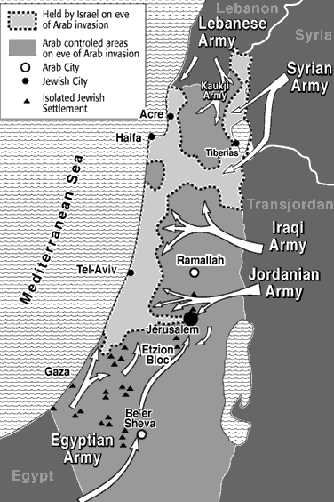 The 1948 Arab–Israeli War, known by Israelis as the War of Independence or War of Liberation and by the Arabs as the Catastrophe.
The 1948 Arab–Israeli War, known by Israelis as the War of Independence or War of Liberation and by the Arabs as the Catastrophe.
On 14 May 1948, David Ben-Gurion declared the independence of the state of Israel, and the 1948 Palestine war entered its second phase, with the intervention of several Arab states' armies the following day.
The war commenced upon the termination of the British Mandate of Palestine in mid-May 1948 following a previous phase of civil war in 1947–1948. After the Arab rejection of the 1947 United Nations Partition Plan for Palestine (UN General Assembly Resolution 181) that would have created an Arab state and a Jewish state side by side, five Arab states invaded the territory of the former British Mandate of Palestine.
Egypt, Iraq, Jordan, Lebanon and Syria attacked the state of Israel, leading to fighting mostly on the former territory of the British Mandate and for a short time also on the Sinai Peninsula and southern Lebanon.
The war concluded with the 1949 Armistice Agreements, but it did not mark the end of the Arab-Israeli conflict.(1)
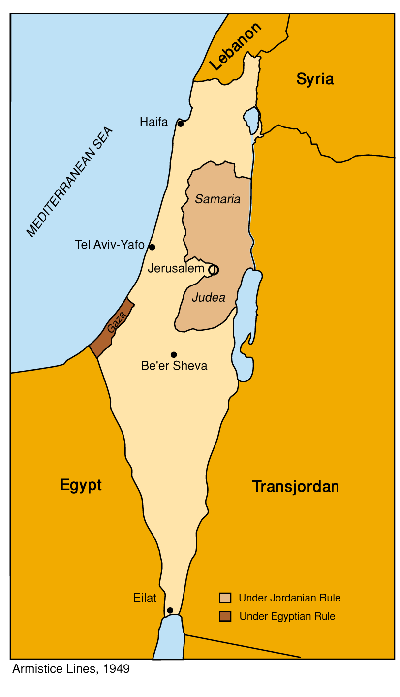 1949 - 1967 Armistice Lines:
1949 - 1967 Armistice Lines:During the first few months of 1949, direct negotiations were conducted under UN auspices between Israel and each of the invading countries (except Iraq which has refused to negotiate with Israel to date), resulting in armistice agreements which reflected the situation at the end of the fighting.
Accordingly, the coastal plain, Galilee and the entire Negev were within Israel's sovereignty, Judea and Samaria (the West Bank) came under Jordanian rule, the Gaza Strip came under Egyptian administration, and the city of Jerusalem was divided, with Jordan controlling the eastern part, including the Old City, and Israel the western sector.
Sometimes the term "green line" is used instead of Armistice Line.
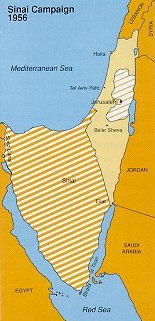 In the early 1950s, Egypt violated the terms of the Egyptian-Israeli armistice agreement and blocked Israeli ships from passing through the Suez Canal, a major international waterway. It also began to block traffic through the Straits of Tiran, a narrow passage of water linking the Israeli port of Eilat to the Red Sea. This action effectively cut off the port of Eilat -- Israel's sole outlet to the Red Sea and Indian Ocean. Closure of the Suez Canal and the Tiran Straits damaged Israel's trade with Asia, for it meant that foreign ships carrying goods bound for Israel and Israeli ships carrying goods bound for the Far East had to travel a long and costly circuitous route to the Atlantic and Israel's Mediterranean ports.
In the early 1950s, Egypt violated the terms of the Egyptian-Israeli armistice agreement and blocked Israeli ships from passing through the Suez Canal, a major international waterway. It also began to block traffic through the Straits of Tiran, a narrow passage of water linking the Israeli port of Eilat to the Red Sea. This action effectively cut off the port of Eilat -- Israel's sole outlet to the Red Sea and Indian Ocean. Closure of the Suez Canal and the Tiran Straits damaged Israel's trade with Asia, for it meant that foreign ships carrying goods bound for Israel and Israeli ships carrying goods bound for the Far East had to travel a long and costly circuitous route to the Atlantic and Israel's Mediterranean ports.
At the same time, Palestinian Arab fedayeen launched cross-border infiltrations and attacks on Israeli civilian centers and military outposts from Egypt, Jordan and Syria. Arab infiltration and Israeli retaliation became a regular pattern of Arab-Israeli relations. In July 1956, Egyptian President Gamal Abdel Nasser nationalized the Suez Canal, threatening British and French interests in oil supplies and western trade.
Their interests converging, Israel, Britain and France planned an attack on Egypt, with the former seeking free navigation through international waters and an end to terrorist attacks and the latter two hoping to seize control of the Suez Canal.
On October 29, 1956, Israel began its assault on Egyptian military positions, capturing the whole of the Gaza Strip and the Sinai Peninsula. On October 31, France and Britain joined the fray and hostilities ended on November 5.(2)
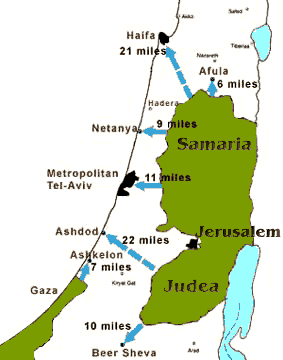 The Six-Day War of June 5–10, 1967 was a war between Israel and the neighboring states of Egypt, Jordan, and Syria. The Arab states of Iraq, Saudi Arabia, Sudan, Tunisia, Morocco and Algeria also contributed troops and arms.
The Six-Day War of June 5–10, 1967 was a war between Israel and the neighboring states of Egypt, Jordan, and Syria. The Arab states of Iraq, Saudi Arabia, Sudan, Tunisia, Morocco and Algeria also contributed troops and arms.
On May 15, Israel's Independence Day, Egyptian troops began moving into the Sinai and massing near the Israeli border. By May 18, Syrian troops were prepared for battle along the Golan Heights.
At the war's end, Israel had gained control of the Sinai Peninsula, the Gaza Strip, the West Bank, East Jerusalem, and the Golan Heights.
The number of Israelis killed were 983, and 4,517 were wounded. 46 Israeli aircraft were also destroyed. 15 Israeli soldiers were captured. Over 9,800 Egyptian soldiers were listed as killed, wounded or missing in action.
Jordan lost 700 soldiers killed, with around 2,500 wounded. Syrian losses are unknown, but are lower than Jordanian casualties.(3)
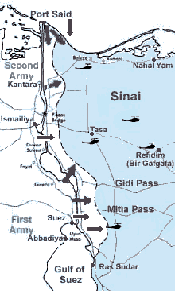
In an effort to force Israel to unilaterally surrender captured lands, Egypt and Syria jointly attacked Israel on October 6, 1973, on Yom Kippur, the holiest day of the Jewish calendar. Other Arab states contributed troops and financial support. Caught by surprise, Israel suffered severe losses in human life and equipment. Following an Egyptian refusal to accept a cease-fire and a Soviet airlift to the Arab states, the U.S. sent an airlift to Israel enabling her to recover from earlier setbacks. Saudi Arabia then led the Arab world in an oil embargo imposed on the United States and other western nations.
In the years following the 1973 war, Israel's enemies realized that they could not defeat Israel on the battlefield. They turned therefore to diplomatic warfare and sought to weaken Israel's international diplomatic position. Due to pressure from the Arab world, most African and third world countries broke diplomatic relations with Israel.
In 1975, the Soviet-Arab-Third World bloc at the United Nations succeeded in passing the infamous "Zionism equals racism" General Assembly resolution which was an attempt to de-legitimize the right of the Jewish people to return to their ancestral homeland. The resolution was not revoked until December 1991. Following a cease-fire, the war officially ended on October 22, 1973.(4)
Other articles of interest include:
1). Wikpedia (http://en.wikipedia.org/wiki/1948_Arab%E2%80%93Israeli_War)
2). ADL (http://www.adl.org/ISRAEL/Record/sinai.asp) - Anti Defamation League.
3) Jewish Virtual Library (http://www.jewishvirtuallibrary.org/jsource/History/67_War.html)
4). http://www.adl.org/ISRAEL/record/yomkippur.asp
Israel Ministry Of Foreign Affairs.